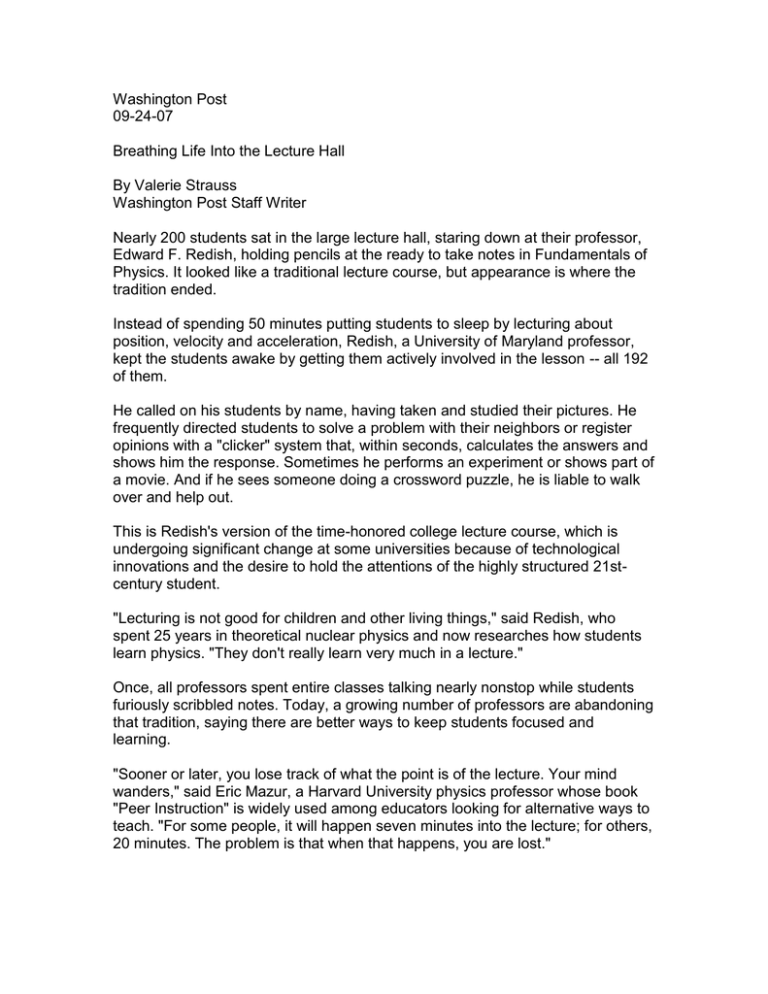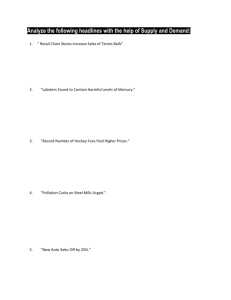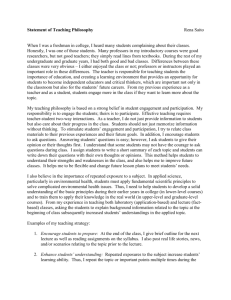Washington Post 09-24-07 Breathing Life Into the Lecture Hall
advertisement

Washington Post 09-24-07 Breathing Life Into the Lecture Hall By Valerie Strauss Washington Post Staff Writer Nearly 200 students sat in the large lecture hall, staring down at their professor, Edward F. Redish, holding pencils at the ready to take notes in Fundamentals of Physics. It looked like a traditional lecture course, but appearance is where the tradition ended. Instead of spending 50 minutes putting students to sleep by lecturing about position, velocity and acceleration, Redish, a University of Maryland professor, kept the students awake by getting them actively involved in the lesson -- all 192 of them. He called on his students by name, having taken and studied their pictures. He frequently directed students to solve a problem with their neighbors or register opinions with a "clicker" system that, within seconds, calculates the answers and shows him the response. Sometimes he performs an experiment or shows part of a movie. And if he sees someone doing a crossword puzzle, he is liable to walk over and help out. This is Redish's version of the time-honored college lecture course, which is undergoing significant change at some universities because of technological innovations and the desire to hold the attentions of the highly structured 21stcentury student. "Lecturing is not good for children and other living things," said Redish, who spent 25 years in theoretical nuclear physics and now researches how students learn physics. "They don't really learn very much in a lecture." Once, all professors spent entire classes talking nearly nonstop while students furiously scribbled notes. Today, a growing number of professors are abandoning that tradition, saying there are better ways to keep students focused and learning. "Sooner or later, you lose track of what the point is of the lecture. Your mind wanders," said Eric Mazur, a Harvard University physics professor whose book "Peer Instruction" is widely used among educators looking for alternative ways to teach. "For some people, it will happen seven minutes into the lecture; for others, 20 minutes. The problem is that when that happens, you are lost." Or as Wenimo Okoya, 19, a junior in Redish's course, put it: "It's boring. A lot of students fall asleep." Gideon Haile, a 20-year-old junior, said the reason he loves Redish's class is because he so "interactive." But, he said, "he's the only one." Professors who have embraced new techniques frequently have turned to PowerPoint, saying it fits the lifestyle of today's students, who grew up with computers, cellphones and other forms of technology and whose lives have been far more structured than those of past generations. Devon Welsh, 21, a junior and natural resource management major at U-Md., said it allows teachers to "give you the simplified version of what they are saying." But some professors say it is making a bad thing worse. Students spend all their time scribbling down what's on the PowerPoint presentation, they say, and that leads professors to structure lessons around the visual presentation rather than creating a lecture with a beginning, middle and end that tells a story and can excite students. "If the old traditional lecture is dying, it is because we are relying so much on the template of technology to make up for the lack of content," said Michael Bugeja, director of the Greenlee School of Journalism and Communication at Iowa State University. "PowerPoint has done more to kill the lecture than people really are aware of." Other instructors have turned to the clicker, a device similar to a remote control, which students point at a receiver in the front of a classroom to answer questions. It also allows professors to determine almost instantly what percentage of students have the right answer. Last week, Redish asked the students to use the clickers to state whether the acceleration in an experiment was positive, negative, zero or impossible to know. Within 10 seconds, he knew that most students had chosen incorrectly. "Eighty-six percent got the wrong answer," he said. "Physics is about data. Our first intuition is not quite right. We have to modify our intuition." Students say clickers keep them engaged, if not entertained. "I feel like I'm in 'ask the audience' on 'Who Wants to be a Millionaire,' " said Landon Katz, 18, a freshman. Of course, there are still some professors who can galvanize a class by using dramatic storytelling, internal structure, movement and a strong voice. Seth Jacobs, a Boston College associate professor of history, said he uses skills he learned in his previous life as an actor, sometimes employing voices other than his own to bring historical figures to life. He has never used PowerPoint, but he has won teaching awards. The problem, some educators say, is that few teachers can bring a lecture to life. "Far too many lecturers tend to read aloud material students could readily read on their own," said Coleen Grisson, professor of English at Trinity University in San Antonio. Harvard University education professor Julie Reuben said a poll of college courses would find that many professors still rely on traditional lecturing as a primary mode of instruction. It's what they had during their college years, said Daniel J. Klionsky, a biology professor at the University of Michigan who has written about the lecture as a teaching tool. And some say the vast class sizes necessitate the format. However, another dynamic exists, Reuben said. Professors often spend their adult lives researching a particular topic and feel they have a unique synthesis and understanding of the research. They want to talk about their work. And although the process of putting together the lectures is a creative, intense experience for professors, it doesn't always translate to students who have to sit and listen, Reuben said. "This is one of the tensions," she said. "How do you have courses in which students have a similar kind of intensive learning?"







